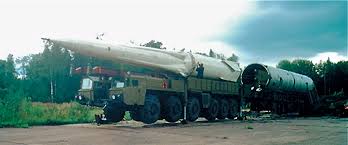
51T6 SH-11 Gorgon exoatmospheric ABM Transporter/Loader, an older type designed as part of a defensive missile ring around Moscow.
A peculiar occurrence happened recently where what looks to be a Russian BUK missile turned around after launch and impacted the area around its own launch vehicle. Speculation on how and why this occurred was painted by many narratives on the conflict. While it may be assumed that the missile or system may have been hacked or manipulated, it is likely the result of poor manufacturing errors or the use of older advanced equipment with degraded safety abilities. While systems like the SA-11 BUK-M1 was high tech for its time and is still extremely effective, it is a complicated system that is filled with several checks before a launch can occur. With so many things that can go wrong, crew training may have not been able to stop that type of accident. The video of that launch can be seen here.
Despite Russia has suffering many losses, the assumption that there is no longer a major threat by Russia towards Western Ukraine and Europe seems to be taken in light humour by some G7 leaders, while those countries bordering Russia and Ukraine are on constant and urgent high alert. NATO soldiers have been training those fighting in Ukraine outside of the territory since the beginning of the war with some reports showing that expanded NATO training inside Ukraine may have already been established. Speeches at the G7 seek to pressure Russia further, but the resulting pressure has increased the value of Russia’s energy so greatly that there economic effects on Russia’s oil exports have done little damage to the value of the Rouble.
Backing Russia into an economic corner without expanding the displacement of its energy exports with North American energy will never be successful as Europe is still largely dependent on Russian energy exports. Other BRICS nations continue their purchases of Russian oil and food into their own economies and seem to have closer relationships with other OPEC members the US is begging for energy assistance. It is clear that Russian export revenues through its energy products is enabling it to continue the conflict, even if it is being depleted of its weaponry. Adding more direct NATO involvement may create a more dangerous situation as opposed to taking a serious commitment in displacing Russian energy exports. While inflation is having a direct and notable impact in Western nations, Russia can still escalate the conflict outside of Ukraine greatly with their long range missile capabilities.
Poland was able to secure later types of the Patriot missile systems after years of delays in obtaining a proper missile defense option for itself. The later models of the Patriot system, called PAC-3, is able to shoot down other missiles, a feature which is now needed as Russia’s proximity and the ability to fire medium range ballistic missiles puts Polish forces at great risk. While the effectiveness of the PAC-3 against fast moving targets has not been properly tested in combat, the lack of response to North Korean missile tests and the fact that some Russian missiles like the Kinzhal can travel as high as Mach 10, makes it difficult to counter some of Russia’s missile systems.
Soviet missile defense technology was always a game changer during the Cold War. Russia’s own defense is tied to that of a early 90s Soviet defense doctrine. While invading Ukraine was always going to be difficult as it was also designed to repel a NATO advance with defense technology from 1990s era equipment, so does later generations of missiles like the S-400 air defense systems make the airspace over Kyiv dangerous for Ukrainian interceptor jets. An advancement of NATO deeper into Ukraine will pull the conflict outside of the range of a Javelin missile type conflict, towards one where Russia has a large ballistic missile advantage. One thing that is certain, is that Russian missile technology is above and beyond other equipment in their arsenal and is often equal or better than their Western counterparts. This has been worked on for a few generations as even a strike on Moscow could be repelled in theory, as Russia has had a significant ABM(Anti-Ballistic Missile) system since the 1950s that is continually upgraded with special missiles designed to repel a nuclear attack and the latest S-500 system. Mobile missiles like TOPOL and SARMAT have been put in position towards Europe, and even have been moved to Northern Russia to target the Arctic Region and North America. In light of the reality, we should expect our leaders to keep their focus on reducing a wider conflict before testing their comedy routines during G7 meetings.